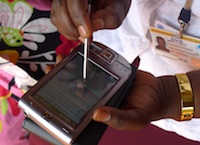Saturday, April 20, 2024
News and Views from the Global South
Handheld Computers Speed Up Burundi Food Aid
Zack Baddorf
- Aid organisations say a small handheld computer will allow them to more rapidly assess where food aid is needed most urgently. As a result, fewer Burundians will suffer hunger this year.

PDAs like this one are speeding up data collection and processing to improve delivery of food aid. Credit: Zack Baddorf/IPS
Fifteen years of civil war, combined with extreme poverty, a fragile political process and recurrent natural disasters like floods and droughts, have caused a drastic increase in poverty and hunger in the central African nation.
Only 28 percent of Burundians have enough food to eat, and more than half of the population is chronically malnourished, according to the United Nation’s World Food Programme (WFP).
WFP plans to distribute 3.7 million tonnes of food to 90 million people in 73 countries in 2010, including Burundi. To determine how best to allocate the available resources, the international organisation conducts food surveys in each country.
“Usually, you’ll send out a monitor with lots of forms,” explains Marc Neilson, WFP public information officer in Burundi. “You simply jot down what residents say on paper, or you may have a questionnaire in paper form, and you check boxes as needed.”
But under a new WFP Burundi initiative, the answers to food assessments are now recorded directly on handheld personal digital assistants (PDAs), which are only a little larger than a cell phone. Since being introduced in March, they have held up against the strong Burundian heat and last for days before needing to be recharged.
WFP Burundi programme assistant Gerard Bisman now uses the new electronic device when he visits rural areas to conduct food assessment interviews. He asks residents questions like ‘How many meals a day are you eating?’ How do you cook?’ ‘What do you use to cook?’ ‘What kind of fuel do you have to cook?’ to determine need for aid.
Saving time
The data Bisman collects will be used to help keep tabs on the country’s food situation. Burundi is considered a “red zone” by WFP, identifying the country as likely to be most affected by food shortages. In past years, WFP has assisted more than 600,000 out of the seven million Burundians with food aid.
The logistics and speed of providing food aid are crucial: almost 40,000 children under the age of five are in danger of dying due to severe acute malnutrition in Burundi at any given moment, according to the International Medical Corps. That means food needs to get to the most needy as quickly as possible.
Each PDA costs about $200, says Neilson. With two devices for each of the country’s 15 provinces, the total cost is about $6,000, excluding staff training costs.
Neilson reckons the PDAs are a good investment because “the poor are getting assistance faster and more effectively”.
“WFP needs to be in the areas that are most at risk and that’s the bottom line. So anything that can help improve that process, reduce the time to get there, improve the data, [and] improve the validity of the data, is to me definitely worth the investment,” he further explains.
No paper trail
Since WFP staff began using handheld computers, more accurate data is collected, and faster, because there is less preparation time and no paper trail from which data needs to be inserted into a computer system later on.
“It used to take us about an hour and a half [per interview, including preparation and data processing], but now it takes only half an hour,” notes Bisman.
Residents who are being surveyed also prefer the new devices, he adds: “They used to get very tired. But with the 30-minute digital survey, they don’t get as tired, and so they provide more accurate data.”
In Bihogo, a village in the north of the country, Bisman asked the 20-plus questions of the digital food survey to Elisabeth Tembaidai, a 56-year-old primary school teacher who received food aid a few years ago and is now again suffering from hunger.
“It’s the dry season, and we are short of food, so we are asking for help,” she explains.
Farmers in Tembaidai’s village had a poor harvest this year, due to a drought combined with poor soil quality resulting from years of deforestation and erosion. According to past WFP assessments, food security in Bihogo has been declining since 2006.
Neilson says interviewing people like Tembaidai using PDAs provides a much more precise picture of the population’s needs: “You have the speed of gathering data, which means you can expand your survey area and interview more people.”
He added that no longer trying to decipher sloppy handwriting and re-typing collected information means a reduced margin of error in the evaluation of the data.
Speedy evaluation
WFP, which has been providing food aid in Burundi since 1968, is in the first phase of implementing the usage of PDAs. For now, information is saved on a memory card and sent to the main office in Burundi’s capital Bujumbura by car. But by the end of this year, fieldworkers will be able to transmit their findings wirelessly, using the country’s new hi-speed 3G wireless network, says Neilson.
A few months ago, Burundi’s telecommunication operators and regulator signed a $20 million project to install more than a thousand kilometres of fibre optic cable, which will bring broadband internet connectivity to the country. World Bank supports the project with a $10.5 million grant as part of its regional infrastructure programme.
If WFP sticks to its plans, Burundi’s poor and hungry will – indirectly – also benefit from the new wireless network, because they will receive food aid quicker than before.

 Print
Print



